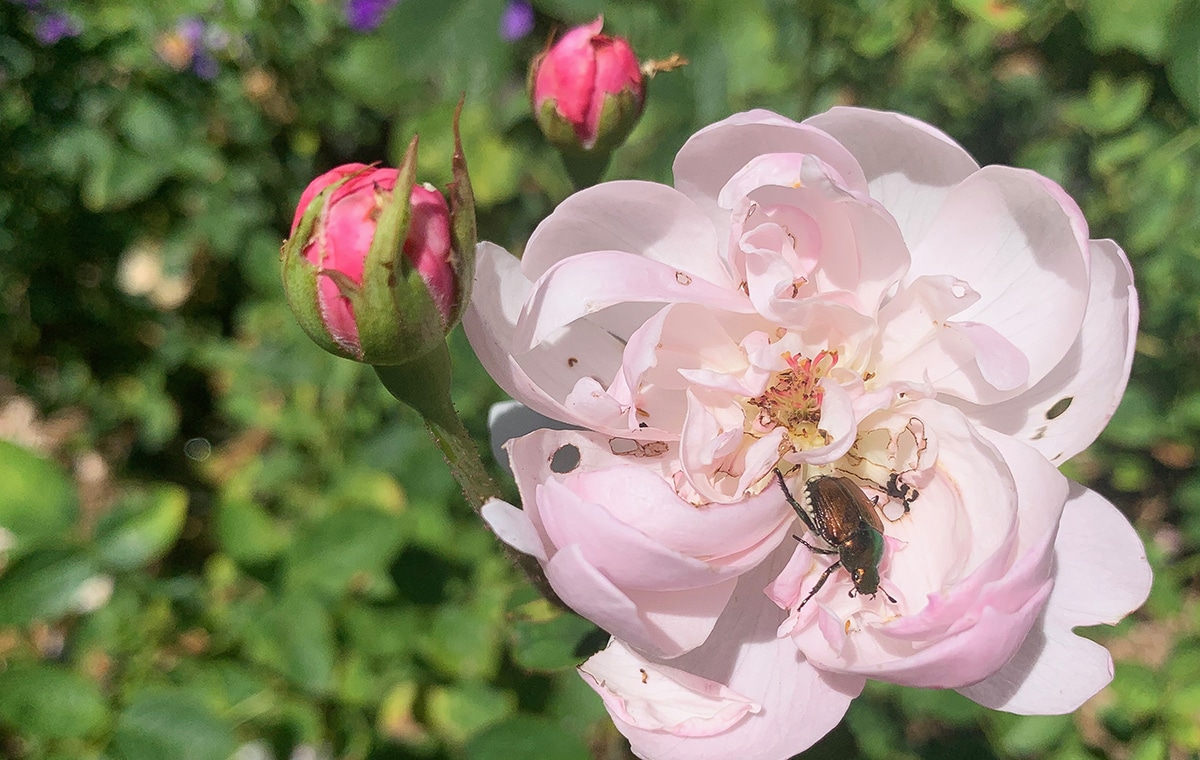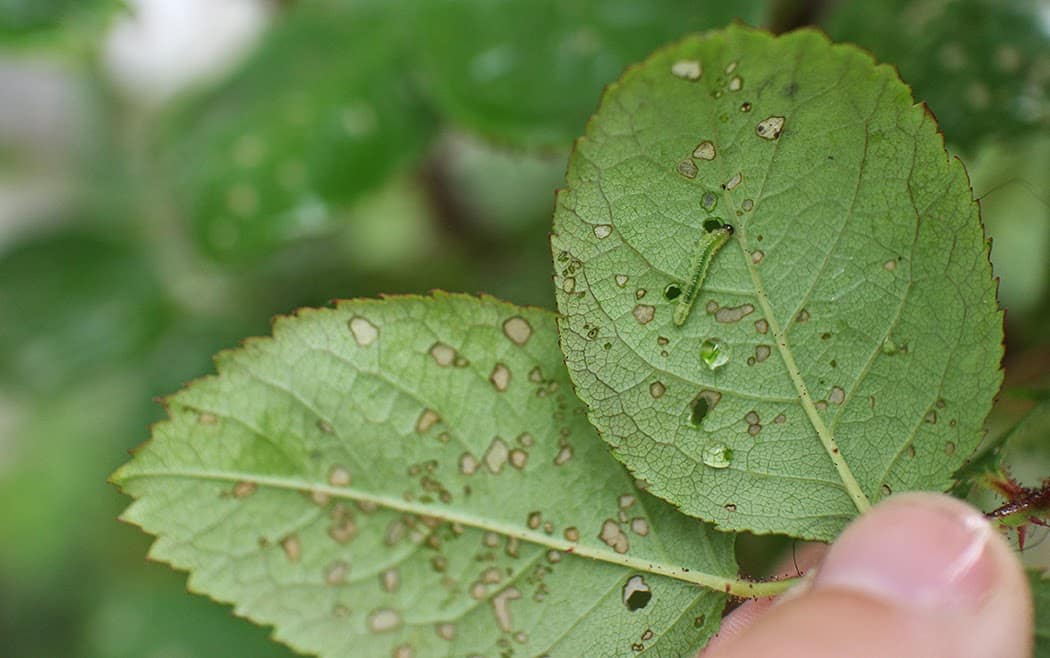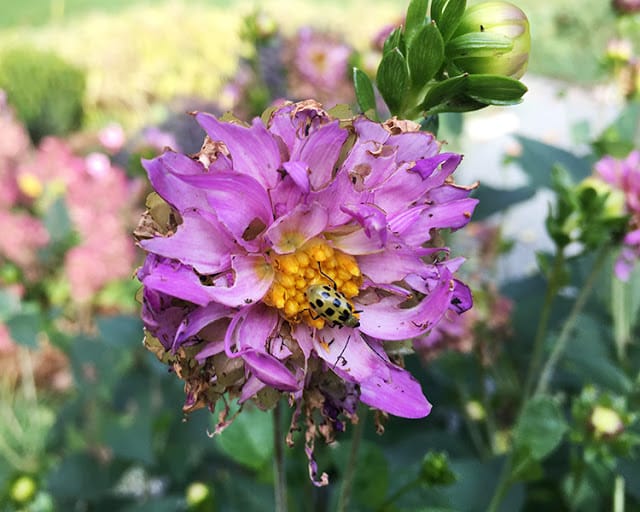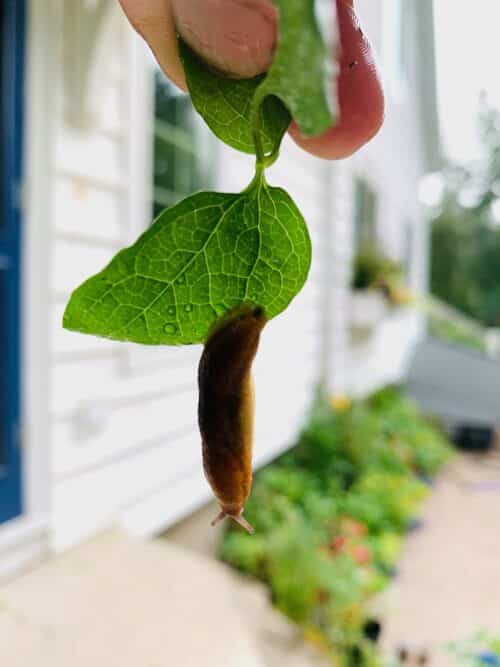I do, on occasion check out a few gardening groups on Facebook. For the past couple of weeks they’ve been full of posts like this:
“What is eating my plant and how do I kill it?”
A variety of answers come in, but in every case there’s at least one answer like this: “Put Sevin dust on it. That kills everything.”
It’s enough to make me want to lose my mind.
But it also got me thinking about how I handle bugs, which is almost always that I just don’t.
Before I continue here I want to make a plea to the gods of gardening karma: Please don’t think I’m getting overconfident and send a plague of locusts/grasshoppers/some other terrible thing to my garden. I promise to remain sufficiently humble.
Honestly, in general, I don’t have a big issue with “bad” bugs in my garden. Oh sure, I’ve had my run-ins with aphids, cucumber beetles and sawfly larvae, and slugs and Japanese beetles are just highly irritating residents now, but for the most part I feel fairly fortunate that dealing with the latest insect onslaught is not often on my radar.
But am I lucky? I think maybe this has a lot more to do with being lazy rather than being fortunate.

Let me back up a bit. When we bought our house in 2002 (I can’t believe it was that long ago), our mailbox was filled with letters from the “pest management” companies that had been contracted by the previous owner to spray for just about everything. Spiders and Asian beetles seemed to be at the top of the must-kill list. We canceled all those services in part because we were young and, having just bought a house, extremely poor.
I gardened a little before we moved into this house, but I became a gardener here. And in the beginning my inclination was to freak out over every pest we had. And then I created more gardens and there just wasn’t time for freaking out, even when I probably should have. But if I noticed a problem I would run to the hardware store or garden center and pick up something in a spray bottle that would probably kill it. I’d hold my breath while I sprayed it and compulsively wash my hands afterwards.
Be a lazy gardener
Somewhere along the line I got a little lazier (or maybe just way too busy in a rapidly growing garden) and a little less interested in anything that might poison me. Yep, at that point I was more worried about killing myself than I was about how anything else would be affected. (Today I’m equally worried about killing everything.) There was just so much label reading (to figure out if it would kill me, and then if it would kill what I was trying to kill), followed by looking up information about it. And it just became easier to just pick off or spray them off with water.
It’s been several years now since I’ve used anything in a spray bottle in my garden, although partial bottles of stuff still fill a shelf in the garage. I don’t fertilize much, but when I do, it’s using an organic fertilizer. (Annual containers get synthetic water soluable fertilizer.) And I make an exception for roses, which get a synthetic rose fertilizer and, I hate to say it, seem happier for it.
I squish sawfly larvae on the roses when I see them, but I feel like there are fewer than there used to be. Japanese beetles are flicked into a jar of soapy water. Each flick is accompanied by an insult directed at the beetle, often one questioning the validity of its parents’ relationship. Aphids, which I’ve blessedly not seen for a couple years, are blasted repeatedly with a hose or wiped off with soapy water.

Slugs are baited with beer, although I find dumping beer traps to be one of the more disgusting garden tasks I face. I tried spraying with a garlic spray that some swear by (which didn’t seem to accomplish much other than making the garden smell like an Italian restaurant). I did finally resort to an iron phosphate pellet (specifically Bonide’s Slug Magic) that is “safe around pets and wildlife.”
Is my garden perfect? Oh hell no. By this time of the summer, the hostas are looking pretty tatty thanks to those damn slugs and I’d love to see a rose flower without a hole in it or Japanese beetle poop on the petals. And I know bugs are just waiting to destroy a crop in the vegetable garden.
A couple years ago I had a terrible attack of cucumber beetles on a group of dahlias just in one area. I picked off what I could but mostly just gave up on those flowers, cut them back and waited until the beetles moved on.

The secret to the relative lack of bug issues in garden lies not with the gardener. A look around gives a clue to what’s really going on. We have a huge toad population. They come out at dusk and you have to be careful where you walk when they emerge from their daytime hiding spots. Frogs are out and about. A diverse population of birds hangs out in our trees. In the past we’ve had a large bat population that entertained us with their evening aerial show, but there seems to be far fewer this year, likely a sign of white nose fungus, which is killing off bats.
Do you see what’s happening here? My laziness and later my decision to garden (almost entirely) organically gave the ecosystem a chance to balance itself out over time. By not over fertilizing I’m not forcing plants to push out the soft growth that aphids and other bugs love.
How I manage pests
It’s not a lifetime cure. There will be other bugs that come in and torture my plants. And when they do here’s what I’ll do:
- Identify the bug. Seriously this is such an important step that I see so many people skipping. You can’t figure out how to manage an insect problem if you don’t know what the insect is. Fortunately, there is a magical tool that allows you to do this yourself most of the time. It’s called Google. See, you type in google.com … Well, you get the idea. Search using a description of the bug and the plant you found it on. Or, send a clear photo of it to your local extension master gardener group or a public university botany department.
- Decide if the bug is good, bad or innocuous. Just how bad is the damage going to be? If it’s just a couple weeks of grossness that won’t kill your plant, maybe you can wait it out. Maybe the insect is important enough that you will look past the damage. For instance, swallowtail caterpillers are likely to eat a good amount of your parsley and monarch caterpillars will decimate your milkweed. Probably best to just plant more next year.
- Start with the easiest and simplest treatment possible. Often this is hand picking them or spraying them with a hose. If I can control the problem this way then it stops there.
- If that easy treatment fails and I really need to save the plant, I will look for a selective (i.e. specific to that pest or a very small group of pests) product to manage it. In addition to researching organic solutions (this is important to me, but it may not be for you), the most important factor I will look for is how it affects beneficial insects. I’m quite likely to skip it all together if there is a risk of it killing beneficial insects.
- Investigate what I can do to prevent it from being a problem next year. For instance, sometimes cleaning up fallen leaves and debris from around the plant can make a big difference.

What you won’t ever find me doing is following that far-too-popular internet advice: shake some Sevin dust on it. Sevin (which is Carbaryl), is non-selective, killing insects indiscriminately both on contact or ingestion. It also has the scariest hazard warning on it: CAUTION: Hazard to humans and animals. To apply it, the label says to wear rubber gloves and to only apply when air is calm and plants are less than chest high. If you apply it to edible crops, you have to do it a certain number of days before harvest. There are a maximum amount of applications you can safely do in a year. Why in the world would anyone want anything to do with this stuff?
Nature is pretty good at managing itself, but humans can screw it up. If being a little lazy helps it take care of itself better, not to mention makes our gardens better, then maybe it’s time to just relax a little when we see a new bug munching on our plants.
I’d love to hear how you approach pest management in your garden. Let me know in the comments. I’m all ears, no matter what approach you take.
Here’s an excellent fact sheet on integrated pest management, selecting an insecticide and more. It’s worth a read.


15 Responses
I have kept a mailbox, on a post, in my garden. It is convenient to store pruners, twine, gloves, etc. I also keep a shaker of salt, in there. It serves two purposes;
1. I pick a ripe tomato, warm from the sun, and eat it, sprinkled with salt, whilst the juices drip off of my elbow.
2. I sprinkle salt on any slugs that I see. It kills the slug, and I quote the Wicked Witch, from the Wizard of Oz, and say “I’m melllllting!.
Thank you for a great article! I too feel the same . ???
I love this and I love your style! Happy gardening!
Amen! The earth is a miracle! Even as “stupid humans” try to intervene. I just let mother nature strut her stuff as I am just an assistant. Enjoy your take Erin. Thanks for sharing.
I’m a Master Gardener in North Texas. I specialize in vegetable gardening and insects. You are right on!
Oh I’m with you!! But how to convince gardeners like my friend, who tries to attract birds and bees to her garden that spraying everything near daily with Miracle Gro is poison to animals? Sigh.
Sheep’s wool…a brilliant slug and snail deterrent. Just a small circle of wool around each plant or on top of pots
I did use a chemical solution on a viburnum that was covered with the eggs of viburnum leaf beetle. But I had an infestation of rose chafer beetles on clematis and on honeysuckle and those I picked off into soapy water. A local business here, St.Francis Herb Farm, had an infestation of those bugs on their newly planted apple trees. The owner spent one night shaking them all off onto a tarp, and then he burned them. It seems that they stay for 2 weeks, then are gone, so if you can manage the two weeks, all will be well again.
Hi Erin,
I like your style! Japanese beetles aka June bugs are amazing in their ability to read the calendar. They are gone by the 4th of July. Admittedly high season in the garden but it helps to know they will soon pack their bags. I have a rose arbor that I give a shake and then run whenever I go by. Hope they get tired of the inhospitable climate of my garden. The only poison I use is on poison ivy. There just isn’t room for both of us in My garden!
Hello,
I let nature take its course in the garden. I try not to spray to protect the pollinators. If I run into problems, I either use soapy water or squish pests with a gloved hand.
There is one pest I plan to identify for next season however and find an organic way to manage it. That’s a type of small caterpillar that destroys every leaf on my Snowball viburnum. I tried squishing them, but they literally covered the entire plant. Yikes! The plant had this problem 3 years in a row so clearly, I need a plan, but that plan needs to be bee, butterfly, bird and toad friendly.
Great article and insight as always. I so enjoy your blog.
Kind regards,
Susan
I use soap water too, however all the Goggle sites I have visited. They recommend with soap water with Neem oil. I’m not so much lazy but cheap. I used mint , lavender, eucalyptus, lemon, and orange oil I had for my oil diffuser.
Another wonderful thing I came up with is instead of dish soap. I used Natures Best , Flea and Tick shampoo. It is all Natural Ingredients with all my diffuser oils.
Good Luck, Kassi Hudson
Being the lazy gardener I don’t do much with pests. Besides the $ I would spend on poison would purchase another plant for the garden! If I see a Japanese Beetle I might squish it but I am squeamish about this procedure.
I laughed out loud at your caption under the first photo, only because I could see that happening. ha…
I once attended a seminar at the Mother Earth News Fair who said with pests in the garden, wait about two weeks. At the end of two weeks, one of two things will have happened: Either something will show up who loves to eat that particular pest, or the pest will have eaten all of whatever it’s feasting on and you can try again next year. And that’s how I garden.
Monches recommended drenching the ground around hosta pips in spring with a solution of ammonia diluted with water – one part ammonia to four parts water. It kills the eggs, greatly reducing the population. I have done this for several years with no harm to the hostas. They also said that a weaker solution of one part ammonia to nine parts water could be sprayed on mature plants. This causes the slug to dissolve so it can be a no-touch way to kill the slugs collected under a wet board or other trap. Some online comments suggest even weaker solutions.